Water Vapor Lidar
Water Vapor Profiling with a Differential Absorption Lidar (DIAL)
Water vapor is the most climate relevant component of the atmosphere. It contributes 2/3 of the whole green-house effect. Water vapor is presumably forcing the antropogenic green-house effect by a factor of 2 or even more, but this is controversily discussed. Particularly changes of the upper tropospheric and water vapor concentration have a large effect on the climate, because long-wave infrared radiation is emitted to space from this region. Thus, precise measurements of the vertical distribution of water vapor in the free troposphere are urgently needed to determine trends.


© by H. Vogelmann © by H. Vogelmann
Conventional vertical sounding techniques cannot easily cover the enormous variabilty of tropospheric water vapor. In order to overcome this limitation a high-power differential-absorption lidar (DIAL) was developed at the Schneefernerhaus high-altitude rearch station (Zugspitze) that allows the vertical distribution of water vapor to be determined in the entire free troposphere (3km to 12km asl.) with a high resolution in time (15 min) and space (50m - 300m) and with a small measurement error (mostly less than 5%). The new DIAL will provide long-term trends, focussed dense time series for studying the impact of atmospheric processes on the humidity distribution as well as data for the satellite validation. The system could impressively prove its capability in many test measurements. Since January 2007 the DIAL has been in routine operation and records water-vapor profiles on 1 to 2 days per week.
Method
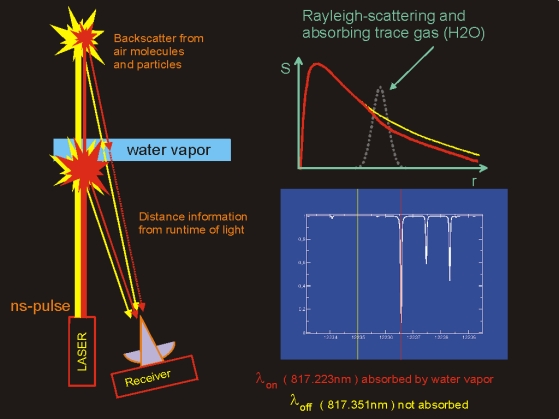
© by H. Vogelmann
The water-vapor DIAL uses short and very intensive narrow-band laser pulses at two closely adjacent "on" and "off" wavelengths in alternating sequence, that are emitted vertically into the sky. The radiation at the "on" wavelength is partly absorbed by a selected spectral line of water-vapor, while the "off" wavelength is located outside the absorption lines. Our DIAL is operated in a weak absorption band in the spectral region around 817nm. The backscattered light is observed time-resolved and integrated over several thousand shots for each wavelength. Water vapor profiles are retrieved by analyzing the differential absorption in the two backscatter signals. The great advantage of the new DIAL, is its daytime capability, even at high altitudes, a property not accessible with the more commonly used Raman lidar-technique because of its backscatter efficiency lower by about four decades.
Laser system
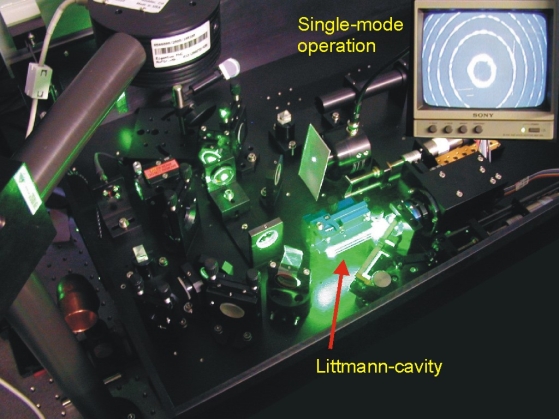
One of the two narrow-band optical parametric oscillators driving the high-power laser system of the water-vapor DIAL, © by H. Vogelmann
In order to reach the full range up to 12km asl. during daytime and under different atmospheric conditions we developed a unique widely tunable (750nm – 900nm) narrow-band (220MHz for 2-ns pulses, spectral purity >99.9%, wavelength stability +- 35MHz ) laser system that is based on two single-mode optical parametric oscillators seeding a flashlamp-pumped Ti:sapphire ring laser. Its pulse energy exceeds the pulse energies of the laser systems used in most DIAL systems by one order of magnitude (250mJ @ 800nm, 2ns). An increase of the pulse energy of the laser system up to 700mJ is planned.

Diagram of the high-power laser system of the water-vapor DIAL, © by H. Vogelmann
Lidar receiver
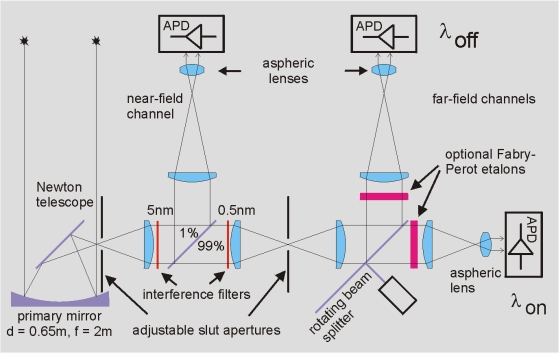
© by H. Vogelmann
The receiver (see figure above) collects the lidar backscatter with a 0.65m Newton telescope. The collected light is separated in near- and far field channels in order to reduce the large dynamic of the lidar signal of 5 decades, and finally detected by avalanche photodiodes (APD). Interference filters (5nm and 0.5nm) are used to block the daylight background. In order to avoid angle-depending artifacts the beam is expanded to almost 5cm (see figure above). The signal is recorded with transient-digitizers (sample rate 20MHz) with a range resolution of 7.5m.
System Characterization
The DIAL system is installed at the Schneefernerhaus observatory on Mount Zugspitze (2675m asl.). Considering the four-decade decrease of the water-vapor concentration up to the upper troposphere, the great advantage of this location is that it is outside the moist planetary boundary layer, which significantly reduces the light-absorption losses at the "on" wavelength. This allows the use of strong absorption lines which enables wide-range measurements even under very dry conditions.
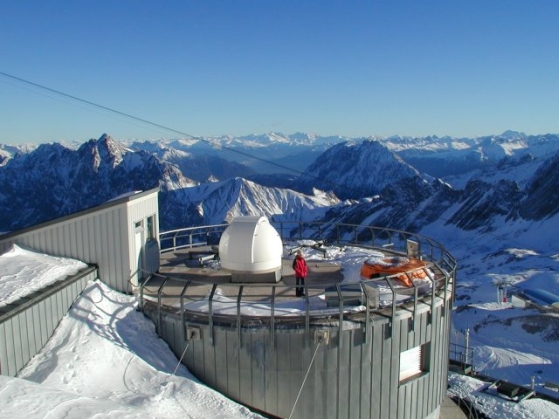
Outside view of the lidar laboratory in the top floor of the Schneefernerhaus, © by H. Vogelmann
The new DIAL has proved its full range and day-time capability in many measurements since 2004. A short validation campaign took place in autumn 2005. Thirteen radiosondes were launched close to the lidar. Some profiles showed a real good agreement up to 8km (see example below, the only difference is a minor, orographically induced vertical displacement).
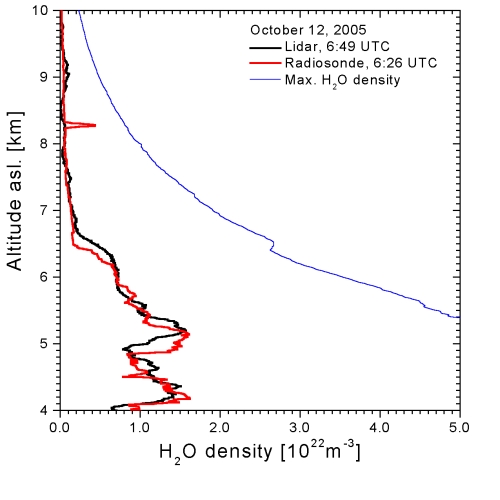
Since January 2007 the DIAL is in routine operation and records water-vapor profiles on 1 to 2 days per week. Some interesting events were observed. The free tropospheric water-vapor column measured with the DIAL in 2007 varied about a factor of 30:
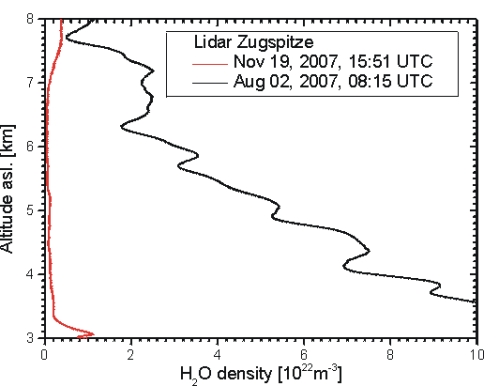
During the extraordinary warm period in February 2007 elevated humidity reached up to more than 13km. The high tropopause is ascribed (by trajectory calculations) to an air mass strongly rising from the Caribbean Sea.
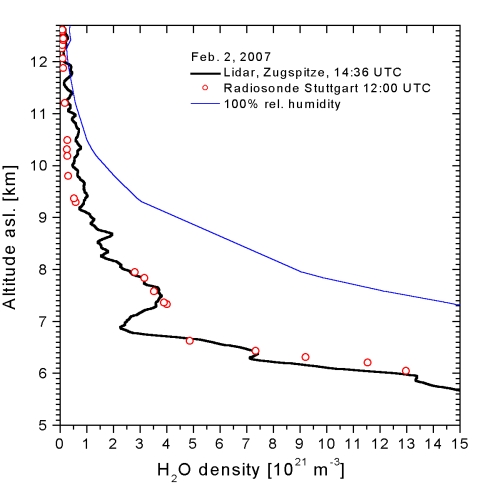
In addition, several stratospheric intrusions have been recorded, characterized by in part very low water-vapor densities. In one case a relative humidity about only 1% was even observed in a rather narrow layer at an altitude of about 3100m asl.:

Reference:
